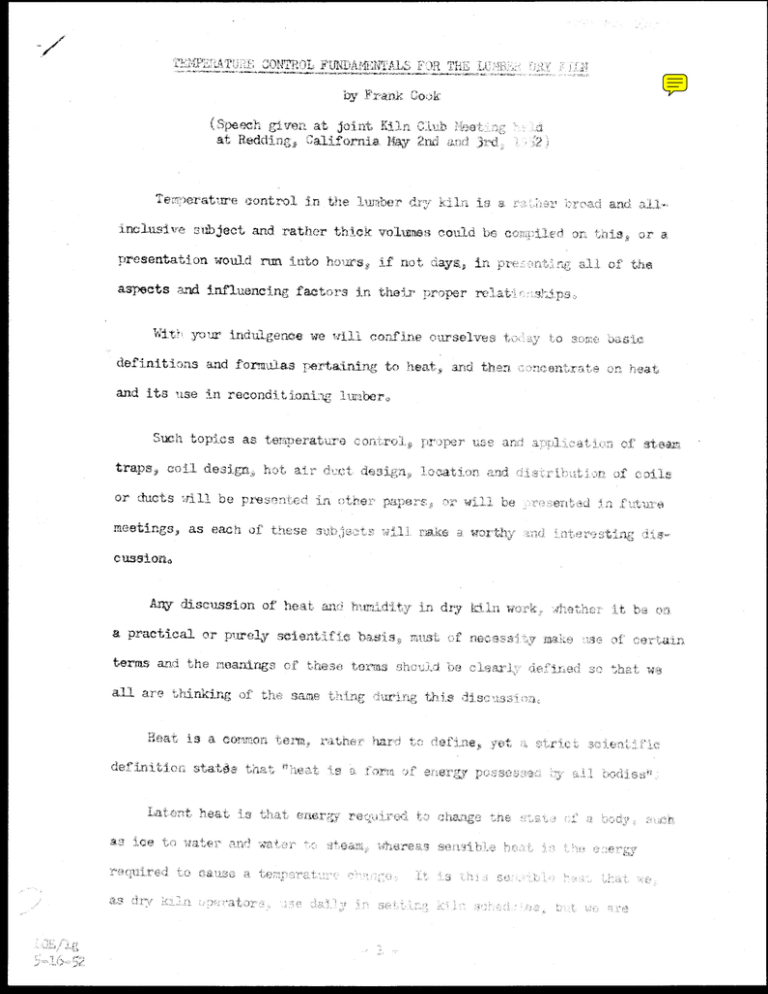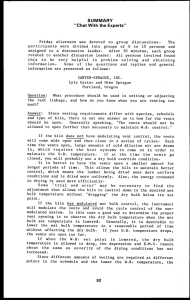r T , Frank Cook
advertisement

rt•NTR T r i j141 ,1011:17IPIL Xi MI:, CI,: Frank Cook giver at joint Kiln CAub Meete_hg at Redding California Hay 2nd and 3-iod T€crat,re control in the lumber dry kiln is a rarha , broad and iibject ect and rather thick volumes could be cc: t9 on this or a presentation would run into hourss, if not cayz-s in pr- eercht aspects and all of the influencing - Actors in their proper relatiehe%ipse, With your indulgence we will confine ourselves t. , to sam 'basic definitions and formulas pertaining to heat s and then, arhceWcrate oh heat and its use in reconditioning lumber,' Such topics as temperature contrel preper use Ord abblizatiem of stean traps, coil des hot air dbet., design location and diarributim, of caila or ducts will be presented in other papers, or will. be rrosen . tad in fitlze meetings, as each of these 1ebjcete7 no:ke a worthy- ibterestiniz di.5- cussionto Any discussion of heat and thimidity in dry kiln werk :iihethei it be on a practical or pnre1r sc"entitle hasish„ mwst bf nec terms and the meanings of the3e to all are thinking of the urine clad make ase of cer'tain be cleariy Aefined so -that we thts dschseibeh. 11,1: Heat is a common term s rather car' to define s yet *, ethiet definition statee that "heot ie form f energ7 p Latcmt hest is that enery . requirc4 ice to wate y' rwsitlired to t7a3 wT,t,er 1emr=5rat clianEe the whemart: senAbl ho.at Cbodist tf a. b.,c17., consoiousl iously workinz asure of this 1-teat / such as encounter troubles / improper temperature distributio insui cient steam' for running the kilns, we are apt to encounter or be working with both types of heat--that is, both sensible and latent. As dry kiln people, we are primarily interested in b.t.u.'s and horse power and their application to our every-day needs. A b.t.u. is defined as the amount of heat required to raise the temperature of one pound of pure , water 10 Fahrenheit from 620 Fahrenheit, and therefore we are working with sensible heat again. A boiler horse power per hour is equal to 33,472 b.t.u.'s per hour, but is normally figured at 33,000 b.t.u.'s per hour. A horse power is also considered the amount of energy required to raise and evaporate 33 pounds of water, since we will see later that it takes approximately 1,000 b.t.u.'s to change one pound of water to one pound of steam. Figuring strictly from a scientific basis, it will require 970 b.t.u.'s, but for sake of ease of manipulation we normally round this off to 1,000. The ability to use these terms and apply them is often considered a tecbnical job, whereas I am sure everyone of us has often wondered how much steam our kilns were using, or how to figure the amount of water that, would be available from the kiln condensate for return to the boilers© This can be determined or calculated by using the formula: Horse power per hour equals the gallons of water per minute, times 8, times 60, divided by In this formula 8 represents the number of pounds per gallon, an6 60 represents the number of minutes per hour. We can also determine the number or amount of condensate that is being made available from the kiln by using the formula: Gallons of condensate is equal to the horse rover per ro 3 dAvided 1h5. produt of 6.x 60, This formula then give us the op portunitr to deten, how Liuuh condensate would be available- hav jrtC a known horse power; We are also interested in wet arid dry bulb readin3 withlth a kiln* is a means of measuring the sensible heat of the dry bulb, and then by measuring the wet bulb we are able to calculate the relative humidity and the equilibrium moisture content, if we desire to use theme The evaporation of water from the wick surroun6ing the wet. bulb thermometer, causes a cooling effect or temperature drop of the thermometer, and this drop is in accordance with the surrounding air's ab l 'iey to absorb water--hence, wet bulb depression and relative humidity0 his relative humidity is not a direct proportion to the increase of the dry bulb temperature with a constant wet bulb reading, but increases tremendously ° For example: If We have a dry bulb reading of 130 0 and a wet bulb of 100 0 „ we have a relative humidity of 35. If we have a dry bulb reading of 150 and a wet bulb of 100, we have a relative humidity of 18. Now, if we were to hol6 a constant dry bulb at 150, and vary the wet bulb, we find a much greater chance. For exam_ o at 110 dry bulb, we have a relative humidity of 23, and at 130° we bulb we have a relative humidity of 57Q We must remember that the wet bulb reading, or vapor pressure within a any one insf 4k; rill be uniform throughout the kiln) whereas thes relative humidity nay vary within the kiln„ due to variations in the dry bulb, This variation can bbe' caused by several factors, such 43 condensate on to': floor, plug g ed traps overflowing w-ter-boxEs or like Before passing on to discussion of heat and its apc.11 at to rcondition- ing of imtor s we ahould make a brief comparion cf the variauz qua lAtis cf eteam ri ten. Ova aa a ba5ic nonnpt, o rointivo hty- Form Po 5514-4 ter vapor in an effor to .; _love stresses in lumber:3 Tam sure all of us have either experienced ours lves„ or talked with operators who said that they were unable to properly condition lumber in an eeonopical way, or in a practical length of time, and disregarding- all other Items ,, such as type of Jn building construction, and. other like factors, let us look clearly at an extract from a saturated steam table, giving the aalities of saturated steam. EXTRACT FROM SATURATED STEAM TABLE Material Temp. Pressure 0F. Total Heat BTUilbe_ 212 180 Volume cuoft./ib4, Water 0 PSI gauge Steam 0 PSI 212 11502 26083 Steam 10 PSI 2140 1160,2 1631 100 PSI 337 1188.9 309 Steam From this table we see ,02 that by adding 970 heat units or botouo e s to one pound of water at 212°, we do not chs.ge the temperature, but we have changed the liquid to vapor and made a tremendous volume change. By adding additional b.t.tu o s to this one pound steam that is now in vapor state, and increasing the pressure to ten pounds, we increase the temperature but conversely decrease the volume. This again holds true when we add more b.t.uc T s and increase the pressure to 100 pounds pressure. This chart, or analysis, then bears out (1) The efficiency of low pressure steam because it is the 970, or approximately 1,000 b.t.u.. 9 s difference between water and steam that does our work with a minimum of loss through flashing when the traps dump,, (2) Pipe size and_ quantity of pipe must be figured on the steam pressure available in the design of kilns in order to insure proper heat control Fora NoG %4'S (3) Loll preoeure steam has the best qeelities for conditioning, because it has t :lowest temperature and thus it will be far easier to get a high wat bulb reading without the sensible heat driving the dry bulb higher and preventing us from getting the vet bulb close to the dry bulb, which is our method of determining relative humidity," With the aforementioned data in mind, let us now progress to the application of the knowledge to the problem of reconditioning of lumberu The reconditioning period during a dry kiln schedule, as is generally accepted, is that portion of the lumber dry kiln schedule which utilizes a high wet bulb and high relative humidity in an effort to put moisture back into the kiln or surface of a board The addition of moisture in the outer area of a board tends to balance toe moisture content of the board s and by softening the outer fibers allows them to become semi-plastic and thus relieve the drying stresses, when the outer core is normally trying to shrink around the inner core0 In general, all lumber that is to be remanufactured by resawing or taking a heavy off of one edge or surface, should be reconditionede This reconditioning is necessary in ier that the board remains stable by having the same noisture content on all surfaces, Naturally the reconditioning of ell lumber put through. the dry kiln is a good "quality pr oedure", but this can only be answered by each individual operator or management policy. In general, all. Shop, Clear„ Select. and Moulding lember should be reconditioned, If knowledge as to the end use of the board is available this should answer the question L5 t whether the stock should he reconditioned; however, not all Sales Departments or Lumber Brokers advise the producing cumpaay of this information, so There Pre In doubt ; reconditiau if you can. rsvso. oe a. aeries of conch iticuing periods during Form 554-6 the course of the drying schedule, whereas others use one period only at the end of the run° Those using periodic conditioning periods during the course of the run, do so in the belief that periodic removal of stresses that have resulted up to that period of reconditioning, are easier to remove and that such periodic reconditioning allows a minimum of stress to occur. Those following the principle of using only one final reconditioning period say that only the final reconditioning, at the desired moisture content of the board, is satisfactory and also that periodic reconditioning treatment extends the drying time out of proportion. In either event, we are all interested in obtaining a given wet and dry bulb condition with a minimum of lost time and a maximum of control, and it is to this and that we are all constantly working° Since the majority of operators are reconditioning their stock in kilns, rather than in separate buildings or chambers, I believe we should give first consideration to their problem° Most kilns in operation today have adequate circulation and dry bulb control, but many are sadly lacking in-- (1) Tight building construction (2) Proper building insulation (3) Tight fitting doors (4) Tight fitting ventilators (5)Adequate steam spray equipment and control It must be remembered that we are interested in a high, water-vapor condition during reconditioning periods, and therefore water, in the liquid state, only tears down the dry bulb condition within the kiln and presents the problem of evaporating this water during the start of the next kiln charge. A building that is not tightly constructed and has poor insulation, L.9 poorly fitting doors and vents, may assist 67' in dissipating heat when the dry Form Noy 554-I bulb starts to rise, because of the hot steam, but these areas then act as condensors and the dry bulb is lower in these areas, and consequently uncontrolled high humidities will be found in these areas, even though the wet bulb is constant throughout the kiln. Many operators have found good use of cooling periods or water sprays very helpful in reducing the ambian temperature of the lumber and kiln, prior to starting the reconditioning period. While they accomplish the end result, they have certain inherent disadvantages such as: (1) Lost kiln production time during cooling. (2) Increased steam consumption after cooling to obtain the desired wet -and dry bulb readings. (3) Maintenance of water-spray equipment, which is a continual source of cleaning the orifices and problems. (4) Tearing down an otherwise controlled dry bulb temperature. (5) Placing a surplus of liquid water on the kiln interior, which retards the drying of the following charge. Those operators having exhaust steam at 10 to 25 pounds pressure available, should not encounter any problems in securing proper conditioning within the kiln, provided that they have thoroughly tight, well-insulated buildings, and a properly designed steam spray system, including proper size diaphragm valve, spray pipe and spray line trap. Those of us having only steam at a pressure of 100 to 150 p.sie avail able find ourselves continnAlly fighting a rising dry bulb condition during steaming or reconditioning periods. This is due to having steam at between 350 and 370° Fahrenheit, which, even though saturated, contains a surplus of heat for our needs. 554-8 During the past few years many various and sundry experiments have been ir the field in an effort to improve wet bulb, and consequently reconditioning aontaol, Many have turned to specially constructed steal-Ling or reconditioning rooms to reduce !atln time and improve conditioning. Water has been injected into steam spray lines in an effort to cool steam or kill the surplus heat, and results have improved slightly under certain optimum conditions, but as a general rule s this has not been a satisfactory answer. The most promising results have occurred where a large diameter pipe is used as an accumulator for 10 to 20 pounds steam. This pipe is hooked directly to the individual, 1401n steam. spray lines and steam is admitted to the kiln through an instrument operated diaphragm valve. The source of steam for this accumulator can be exhaust or flash steam from-trap action or turbines„ with the provision for , additional steam from the main steam supply being admitted to this accumulator through a reduction or pressure controlling valve when needed. Provision must be made for killing the surplus or super-heat steam of this reduced steam by either water venturis or like means. This 100 P.S.I. steam at 337 0 F. can be reduced to 10 pounds steam, which has a normal temperature of 240° Fahrenheit; however„ simply reducing the steam pressure has not changed the temperature, although it has changed the volume and pressure. Thus we have approximately 100 0 F, of surplus heat that we must get rid of. This can be d 7,g a water injection 9 which means that water is used to kill this flash, or the line can be left uninsulated3 i s a means of radiating S surplus heat. ator can cith be a large diameter pipe hung acr control room, ersize tank suah as an old boiler shello Form No. 594-9 Natural_ e larger the size of the acewulator, the better as to volume is the holding capacity of this unit, as volume is a critical component of such a system, We have learned from the previous discussion the large volume differential between 110 pounds steam and this cannot be overlooked, The Maling or elimination of the superheat, as previously discussed, i a critical problem, but if done in an oversize pipe or tank, adequate provisions can be made whereas surplus water, in the liquid state, will not be carried into the kiln and where heating efficiency is not eliminated, Several installations in this area have this type of steam spray equipment, such as the Ralph L„ Smith Lumber Company at Anderson, and the U. S. Plywood Corporation, Bear Creek Division, at Anderson. I would like to point out at this stage that no definite set of rules or conditions concerning the attainment of a desired wet and dry bulb condi- tion can be made because, again such factors as: (1) Size of kiln in comparison to size of spray line (2) Tightness of building construction (3) Type of building construction as to insulation (4) Quality of steam available all have a direct bearing on proper attainment in control of reconditioning schedules, Several operating companies have, after analysis, found that the re- conditioning problem has caused them excess lost kiln drying production time and, therefore, have turned to specially constructed rooms wherein lumber is removed from the actual kiln rooms and placed in these rooms for recondition„o Although it may appear on the surface to be an ideal answer, careful to the co8t of such a unit, its efficiency as erent kiln facilities, and the cost of rehandling lumt r feee tfi h kiln nnit3 e and from the reconditioning units.° .A33 tilt.T,Ctt 1"c ,31,1 T.7.raetleal V) use special reconditioning units, let eee eeet, their requirements mdst beo The 312,3 of these units win e of course s be dependent on the cost of the eize ef t,he actual Kiln drying units s the production of: stock that is to be xeconditj'j and the amount of stock to he placed in the unit for actual reeenditioning s and the length of the reconditioning periodo Normally the reconditioninr unit should hold one complete kiln charge le order tn hande_e stock hnviag been subjected to comparable kiln drying eenditicae tresses, if the kilns al) consisted of large double track unies s it mieht then be practical to consider a unit holding just half the 4t1:1 charges however s as pointed out s the actual size of the unit must he determined by a thorough investieation of the problem confronting each individual particular concern. Buildirg. construction for these special chambers must, of necessity s be tight to prevent loss of heat and vapor pressure. Slight holes in the (save joints or around the doers weld again lower the thy bulb reading and give ttebaLanced eeiative humidity- within the unit, Special considee'ation mthet be given to having a waterproofed building enfi welle i msulated buildingto p revent heat loss and in an effort to guard against building deterioration s due to the rottins of wood timbers or the re-At-lee of metal nenbere, We have ala seen the deterioratdon of wood kilns tkrve eele eee l eere ealleed: by 1.s..r-e.kr- ent. 1.1 2ue to the oj in both the wet and dry the ae have also seen the affect of wood acids on metals within kilns, but, of course, this is primarily dependent upon the species of lumber being handled. Now with a well-constructed building, let us see what equipment needs are required to give us controlled conditions© Air circulation is required in order to properly control dry bulb conditions and prevent hot-spots from occurring near the ceiling or in those areas containing the heat coils, if found necessary, or the steam spray lines. As in a dry kiln the wet bulb or water-vapor pressure will be mtform and, therefore, the circulation is for dry bulb conditions alone. Since this circulation is for proper distribution of dry bulb conditions and need not be used for actual drying of the lumber, the high volumes and velocities normally found in modern kilns are not required. Although circulation is required, its importance is much less than in kilns; therefore, it can be obtained either by relatively fewer and smaller fans, or can even be attained by proper design of the steam spray jets that emit steam to the units. The design and installation of jets for the purpose of circulation requires careful consideration and planning and the easiest approach is through the use of fans. Control of water-vapor is the prime target of this unit and therefore we must find a means of introducing and control/lng this vapor in the conditioning unit. Those of us operating steam heated kilns have this required vapor available in the form of steam, and as long as we can control the steam, as previously discussed, it is through his controlled steam that we in turn control water-vapor. The use of low temperature saturated steam is onr goal, so, as in the ease of controlling this steam within dry ki lns, here again we must control the steam or water-vapor as to volume, temperature, and prevent liquid water Form No. 554-12 or condensate gaining entrance into the conditioning room and upsetting the designed dry bulb settings. As in the case of regular dry kilns, we must control the dry bulb. Depending upon the species being handled, location and climatic areas of the plant, the desired wet and dry bulb settings, the requirements as to heating coils within such a unit must be analyzed from that particular installation. Some operators have found that by using 100 pound pressure steam through one spray line and 10 pound pressure steam through another spray, they can control both wet and dry bulbs. This is done by having a control instrument hooked so that the dry bulb control and set handles the high pressure, or 100 pound pressure steam, and the wet bulb control of the instrument is hooked to the 10 pound pressure steam. The dry bulb setting then controls the 100 pound pressure steam, which, although has some water-vapor, has a surplus of heat. The wet bulb control then controls the low pressure steam which is relatively low in heat but high in water-vapor. Some may wonder why we consider control over the dry bulb necessary, because aren't we primarily interested in high humidities which, in turn, mean getting the wet bulb as close as possible to the dry bulb. Control of the wet and dry bulbs independently is a prerequisite to proper reconditioning as some species will develop stain or drying defects if left uncontrolled with too high a reconditioning schedule, or length of time. These defects can manifest themselves primarily in reverse case-hardening and some types of stain. Controlling instruments are a worthy help to the operating personnel because they allow him to ask for a set of conditions, give him a record of actual conditions and, if properly installed, will attain the desired conditions. Normally ventilators and their automatic control trill not be required in reconditioning, This again, however, is only true if we have r positive control on the wet and dry bulb and stock has been dried below 20%. However, a positive answer as to the necessity of vents and their control would again be dependent on other designed features of the reconditioning unto Reconditioning of lumber has to date been a prerequisite of properly seasoned lumber and it is with this in view that proper controls and equipment must be designed and installed to allow this controlled reconditioning with a minimum of maintenance and a maximum of production. Many problems surrounding the reconditioning can be solved by maintaining accurate records of the condition of the lumber prior to and during actual reconditioning, as well as a practical analysis of the actual operating conditions within the unit. Qualified personnel in the field of kiln design should be called upon to assist in these problems, Lf necessary. Thank you very much. MORE DRY KILN COMPANY Vancouver„ B, Jacksonville, Florida. North Portland, Oregon Brampton Ontario LOB/ig 5-16-52 -






